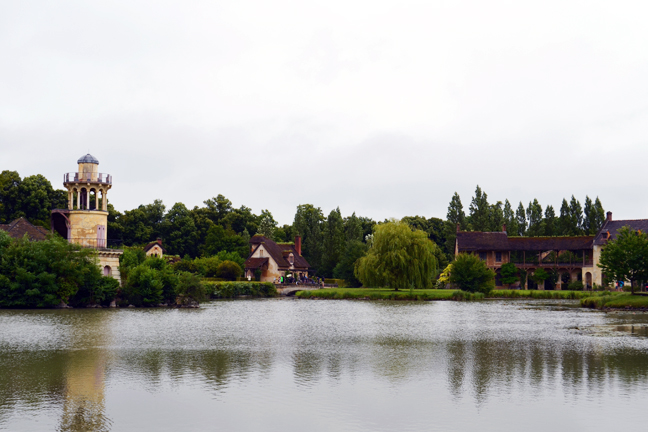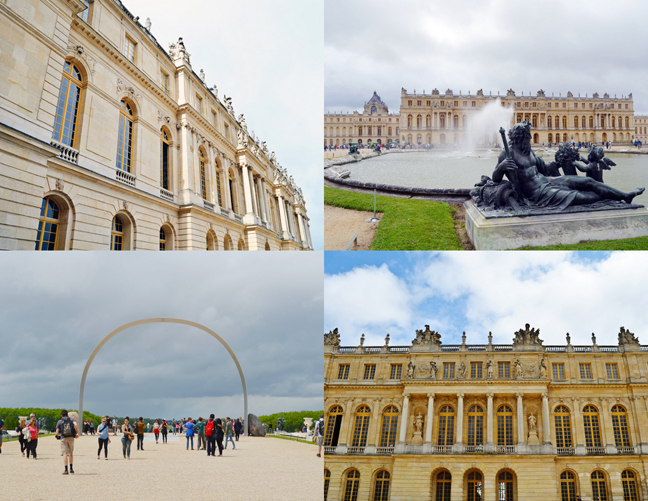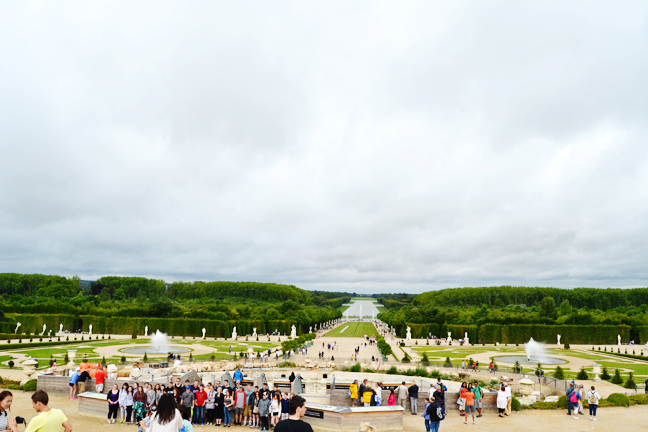On our second day in Paris we headed to the Palace of Versailles. Here are some aerial views from the internet since I don't have a plane to fly over and see the complex and grounds in their entirety. But you just need to see how magnificent this place is from above.

The Versailles Château is MASSIVE and HUGE and LONG!
Old painting of Versailles.
Pretty much all of the green you can see is the manicured lawns and grounds of Versailles.
We rode a couple of metros and then took a half hour train out to Versailles without a hitch. The public transportation system of Paris is super efficient.

The Versailles Château is MASSIVE and HUGE and LONG!
Old painting of Versailles.
Pretty much all of the green you can see is the manicured lawns and grounds of Versailles.
We rode a couple of metros and then took a half hour train out to Versailles without a hitch. The public transportation system of Paris is super efficient.
Oh Fox.
This stately statue of King Louis XIV on his noble steed greets visitors before they enter the golden gates of the Château.
Every king's dream, Versailles (vehr-sigh) was the residence of French monarchs and the cultural heartbeat of Europe for about 100 years - until the Revolution of 1789 changed all that. The Sun King (Louis XIV) created Versailles, spending freely from the public treasury to turn his dad's hunting lodge into a palace fit for the gods (among whom he counted himself). Louis XVI spent much of the 18th century gilding Louis XIV's lily. In 1837, about 50 years after the royal family was evicted by citizen protesters, King Louis-Philippe opened the palace as a museum. Today you can visit parts of the huge palace and wander through acres of manicured gardens sprinkled with fountains and studded with statues. Seems like a lot of the palaces we've been to were modeled after Versailles - but none can compare!
Versailles offers three blockbuster sights. The main attraction is the palace itself called the Château. Here you walk through dozens of lavish, chandeliered rooms once inhabited by Louis XIV and his successors. Next comes the expansive Gardens behind the palace, a landscaped wonderland dotted with statues and fountains. Finally, at the far end of the Gardens is the pastoral area called the Trianon Palaces and Domaine de Marie-Antoinette, designed for frolicking blue bloods and featuring several small palaces and Marie's Hamlet - perfect for getting away from the mobs at the Château.
Our family on Saturday July 5th 2014 at the Palace of Versailles.
Even though we were Paris Museum Pass holders we still had to wait in the loooooooong security line. After about 10 minutes standing in the slow-moving queue a guard grabbed us and a few other families with strollers and brought us to the front of the line. Score! We got right in and went through room after room of information and models and paintings of and about Versailles.
Versailles is the symbol of the ancien régime, a time when society was divided into rulers and the ruled, when you were born to be rich or to be poor. To some it's the pinnacle of civilization; to others the sign of a civilization in decay. Either way, it remains one of Europe's most impressive sights.
Versailles was the residence of the king and the seat of France's government for a hundred years. Louis XIV (r. 1643-1715) moved out of the Louvre in Paris, the previous royal residence, and built an elaborate palace in the forests and swamps of Versailles, 10 miles west. The reasons for the move were partly personal - Louis XIV loved the outdoors and disliked the sniping environs of stuffy Paris - and partly political.
Louis XIV was creating the first modern, centralized state. At Versailles he consolidated his government's scattered ministries so that he could personally control policy. More importantly, he invited France's nobles to Versailles in order to control them. Living a life of almost enforced idleness, the "domesticated" aristocracy couldn't interfere with the way Louis ran things. With 18 million people united under one king (England only had 5.5 million), a booming economy, and a powerful military, France was Europe's #1 power.
Around 1700, Versailles was the cultural heartbeat of Europe and French culture was at its zenith. Throughout Europe when you said "the king" you were referring to the French king - Louis XIV. Every king wanted a palace like Versailles. Everyone learned French. French taste in clothes, hairstyles, table manners, theater, music, art, and kissing spread across the Continent. That cultural dominance continued, to some extent, right up to the 20th century.
At the center of all of this was Europe's greatest king. He was a true Renaissance Man, a century after the Renaissance: athletic, good-looking, a musician, dancer, horseman, statesman, patron of the arts, and lover. For all his grandeur, he was one of history's most polite and approachable kings, a good listener who could put even commoners at ease in his presence.
Louis XIV called himself the Sun King because he gave life and warmth to all he touched. He was also thought of as Apollo, the Greek god of the sun. Versailles became the personal temple of this god on earth, decorated with statues and symbols of Apollo, the sun, and Louis XIV himself. The classical themes throughout underlined the divine right of France's kings and queens to rule without limit.

Louis XIV was a hands-on king who personally ran affairs of state. All decisions were made by him. Nobles, who in other countries were the center of power, became virtual slaves dependent on Louis XIV's generosity. For 70 years he was the perfect embodiment of the absolute monarch.

Three kings lived in Versailles during its century of glory. Louis XIV built it and established French dominance. Louis XV, his great-grandson carried on the tradition and policies, but without the Sun King's flair. During Louis XV's reign (1715-1774), France's power abroad was weakening and there were rumblings of rebellion from within. With France's monarchy crumbling, the time was ripe for a strong leader to re-establish the old feudal order. They didn't get one. Instead they got Louis XVI (ruled 1774-1792), a shy, meek bookworm, the kind of guy who lost sleep over revolutionary graffiti... because it was misspelled. Louis XVI married a sweet girl from the Austrian royal family, Marie-Antoinette, and together they retreated into the idyllic gardens of Versailles while revolutionary fires smoldered.

We walked through fancy room after fancy room and saw the Royal Opera House, the intimate two-tiered Royal Chapel, the glamorous State Apartments, the King's Wing with billiard room, royal make-out room, the Swiss bodyguard room, Louis' official bedroom, the grand throne room, and his war rooms. It was sooooooo crowded. I don't think I've ever been in a place as crowded before. So we rushed as fast as we could to get through - which wasn't very fast, ha!

I spent the most time in Marie-Antoinette's bedroom - I loved the wallpaper and decor!

Louis XIV was a hands-on king who personally ran affairs of state. All decisions were made by him. Nobles, who in other countries were the center of power, became virtual slaves dependent on Louis XIV's generosity. For 70 years he was the perfect embodiment of the absolute monarch.

Three kings lived in Versailles during its century of glory. Louis XIV built it and established French dominance. Louis XV, his great-grandson carried on the tradition and policies, but without the Sun King's flair. During Louis XV's reign (1715-1774), France's power abroad was weakening and there were rumblings of rebellion from within. With France's monarchy crumbling, the time was ripe for a strong leader to re-establish the old feudal order. They didn't get one. Instead they got Louis XVI (ruled 1774-1792), a shy, meek bookworm, the kind of guy who lost sleep over revolutionary graffiti... because it was misspelled. Louis XVI married a sweet girl from the Austrian royal family, Marie-Antoinette, and together they retreated into the idyllic gardens of Versailles while revolutionary fires smoldered.

We walked through fancy room after fancy room and saw the Royal Opera House, the intimate two-tiered Royal Chapel, the glamorous State Apartments, the King's Wing with billiard room, royal make-out room, the Swiss bodyguard room, Louis' official bedroom, the grand throne room, and his war rooms. It was sooooooo crowded. I don't think I've ever been in a place as crowded before. So we rushed as fast as we could to get through - which wasn't very fast, ha!

I spent the most time in Marie-Antoinette's bedroom - I loved the wallpaper and decor!
She sure had a flair for fashion!
At last we came to THE room. The Hall of Mirrors! This room was under construction when I was here in 2005 so I was excited to see it. The Hall of Mirrors at Herrenchiemsee that we saw in May is nearly identical so I didn't feel so bad hurrying through.
The Hall of Mirrors is 250 feet long with 17 arched mirrors matching 17 windows looking out upon the royal garden views. The mirrors - a luxury at the time - reflect an age when beautiful people loved to look at themselves. In another age altogether, this was the room in which the Treaty of Versailles was signed, ending WWI.
After touring the Château and before starting our walk through the massive grounds, we got some snacks.
Our family in front of the Château at Versailles.
What is that arch thing???? I hope it's not permanent! All around the grounds we saw wacky "art"; you'll see.
I couldn't fit the entire Château in my photos!
How can this fugly arch compare to these classy statues? Don't get me wrong, I'm a BIG fan of modern art, but there's a time and place for it and I don't think it should be here at Versailles; it's such an eyesore.
Sigh. I want to live at Versailles :)
So we walked around, took lots of photos, people-watched, took photos of people who requested me to, and vice-versa.
The Gardens offer a world of royal amusements. The warmth from the Sun King was so great that he could even grow orange trees in chilly France. Louis XIV had a thousand of these to amaze his visitors. In winter they were kept in the greenhouses underground. On sunny days the were wheeled out in their silver planters and scattered around the grounds.


The grounds seem to stretch out forever!
Versailles was laid out along an eight MILE axis that includes the grounds, the palace, and the town of Versailles itself, one of the first instances of urban planning since Roman times and a model for future capitals such as Washington DC and Brasilia. A promenade leads from the palace to the Grand Canal where France's royalty floated up and down in imported Venetian gondolas.
See, what the heck are these huge slightly bent metal sheets?!?! Argh!
Cute and quaint cafés.
We meandered slowly down to the impressive Apollo fountain.
We had to pay about 20 euros extra because the fountains were running today.
You can rent canoes and go floating on the water. It was raining pretty much the entire time we were there so we opted out of this experience. Next time? :)
I finally got a nutella crepe! Yummers.
Looooong shady walkways everywhere. | What the heck is that big, black, flat sheet blocking my lovely view? Not art!
We followed our map to the Trianon Palaces and Domaine de Marie-Antoinette. I'd never been there before and was excited to see some new things.
I wanted to run and frolic in this forest.
Versailles began as an escape from the pressures of kingship. But in a short time the Château had become as busy as Paris ever was. Louis XIV needed an escape from his escape and built a smaller palace out in "the boonies." Later, his successors retreated still further from the Château and French political life, ignoring the real world that was crumbling all around them. They expanded the Trianon area, building a fantasy world of palaces and pleasure gardens - the enclosure called Marie-Antoinette's Domaine.
Jane and Fox in front of the gold gates at the entrance to Marie-Antoinette's palace.
The beautifully restored Grand Trianon Palace is as sumptuous as the main palace, only much smaller. It has a pastel PINK facade and more human scale. I love it.


We went inside and had to walk through the gift shop to get to the tour. I loved all the cute Marie-Antoinette treasures and knick knacks.
Oh my WOW.
Favorite palace EVER!
Every room was so COLORFUL!
This mustard yellow room was my fave. I think Marie and I could have been friends with our shared love of bright colors :)
In between wings is a covered walkway with a checkerboard floor. There was a bride and groom getting their wedding photos taken - definitely an ideal location!
Fox running in circles around this circle.
The other wing was just as pretty!
I wanted to take this rug home with me.
And these padded stools were flippin' CUTE!
It started raining cats and dogs when we exited the palace, which made for nice and empty photos of the beautiful grounds.
People walked around a lot for fun back in the day!
Bye bye pink palace!
Then we walked to the area known as the Hamlet.

You can almost see princesses bobbing happily in the branches as you walk through the enchanting forest, past the white Temple of Love, to the queen's fake-peasant Hamlet.

You can almost see princesses bobbing happily in the branches as you walk through the enchanting forest, past the white Temple of Love, to the queen's fake-peasant Hamlet.
My most favorite European activity is walking around beautiful grounds like this, especially when there aren't many people because of rain. I think the rain adds something special.
Looking up inside the Temple of Love.
Marie-Antoinette's happiest days were spent at the Hamlet, under a bonnet, tending to her perfumed sheep and manicured gardens in a thatch-happy wonderland.
Marie-Antoinette's happiest days were spent at the Hamlet, under a bonnet, tending to her perfumed sheep and manicured gardens in a thatch-happy wonderland.

Despite her bad reputation with the public, Marie-Antoinette was a sweet girl from Vienna who never quite fit in with the fast, sophisticated crowd at Versailles. She made the Petit Trianon, a masterpiece of Neoclassical architecture, a place to get away and re-create the simple home life she remembered from her childhood. Here she played while in the cafés of faraway Paris revolutionaries plotted the end of the ancien régime.
This place really did look straight out of fairytale.
Pretty darn strange that it was all built as a fantasyland of sorts!
Reminds me of Disneyland in a way.
An entire fake, little, homely village!
I wonder what's inside the buildings and if people lived there or if they were empty like treehouses?
Fascinating what Marie-Antoinette did for entertainment.
In case you can't tell, I couldn't stop taking pictures of the Hamlet!
Grazing cows. I wonder if they were perfumed like her sheep were? :)
Once we finished sight-seeing at the Hamlet we made our long 45 minute trek back to the train station.
And rode back to Paris.
It was fun to feel like kings and queens for a day in the majestic Château and grounds of Versailles!



















































































Such gorgeous places!!! LOVING all the photos!! And you are right ... that modern art just doesn't fit at all!
ReplyDeleteI really enjoyed reading the history and seeing your photos! Thank you!!
ReplyDeleteWOW! I love the colorful rooms. I've been there a few times but never wandered out further than the fountain. I'll bet it was hard to imagine being a princess with that crowd around you, but I'm betting you tried!
ReplyDeleteVersailles, what a dump :)
ReplyDeleteWhat an amazing place to visit!! I love the touches of Gold and that Mustard colored room is so fab! And how awesome is the Hamlet!! Could totally live there!
ReplyDeleteLove all of the gold...so amazing. Love that you share all of this!
ReplyDelete